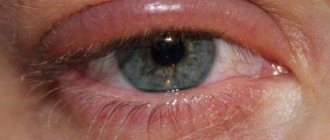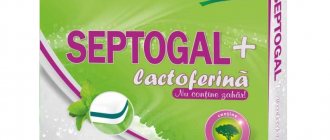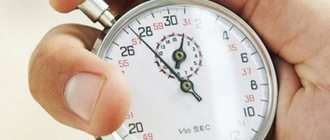What is an ingrown toenail?
With this disease, the nail plate grows into the periungual fold. The big toe is most often affected. The disease begins with some “provoking” moment - an injury during a pedicure, a bruise, wearing tight shoes, etc. Swelling of the roller occurs, it is pressed more tightly against the nail plate and is slightly injured by it (an abrasion, a microcrack occurs). This, in turn, causes increased swelling and pain. Almost immediately an infection sets in - microorganisms invade the wound. Inflammatory phenomena gradually progress - redness appears in the area of the periungual fold, pain and swelling increase. Pus begins to secrete between the nail and the roller, and later hypergranulations appear there (the so-called “wild meat”). Before infection sets in, ingrown toenails can still be stopped by treatment at home - it will be described below. When suppuration occurs, and especially when “wild meat” appears, conservative treatment is always ineffective; it can only bring a short-term reduction in symptoms. Only surgical intervention can radically help.
Classification of onychocryptosis
Onychocryptosis can go through three stages of development:
- mild, when changes in the plate are not yet visible, but there is pain, discomfort, swelling and inflammation of the periungual ridges;
- moderate, when the tissues of the terminal phalanx are hyperemic, edematous, and infiltrated. The nail plate becomes dull and thickened;
- heavy when the plate becomes thin and brittle. The periungual ridges are swollen and covered with hypergranulations. When the nail folds are affected on both sides, the volume of the phalanx increases.
Onychocryptosis can occur both without inflammation and with the addition of infection.
Causes of ingrowth - why does it happen
Most often, an ingrown toenail (synonymous with onychocryptosis) is the result of a combination of several causes.
- Trauma - can be caused by a pedicure (even an unsuccessful tearing off of a small hangnail can cause swelling of the roller, and this will provoke an ingrowth), direct trauma (blow, bruise).
- Wearing tight, uncomfortable shoes, especially with a narrow “toe” and high heels.
- A large (congenital) periungual ridge is one of the serious causes, which, despite numerous operations, can cause repeated ingrowths (relapses). Plastic surgery of the periungual fold helps solve the problem - it will be described below.
- Flat feet - when the first toe deviates outward, there is excess pressure on the cushion from the side of the second toe.
- Pregnancy and the postpartum period - according to statistics, the likelihood of ingrowth increases during this time, apparently, this is due to a temporary change in posture and foot settings.
- Fungal infections of the nails deform the nail and increase the risk of disease.
The direct cause of an ingrown toenail can be either one of the predisposing factors or a combination of them.
Symptoms
Diagnosing an ingrown toenail is usually not difficult. The main symptom is pain in the area of the periungual fold, first with pressure, and then at rest. Swelling and redness quickly develop. Pus soon begins to appear between the roller and the nail. Redness increases, and with the use of various remedies it may temporarily decrease, but almost always the process becomes chronic and can last for months. Chronicity of the disease is characterized by the appearance of hypergranulations (“wild meat”). In very rare and advanced cases, inflammation can spread to the phalanx bone - osteomyelitis.
There are usually no changes in the patient's general condition. In a blood test, there may be a slight increase in the number of leukocytes during acute inflammation and an increase in ESR. With prolonged ingrowth, it is necessary to perform an x-ray of the finger to exclude involvement of the phalanx bone in the process - osteomyelitis.
Diagnosis of the disease
First of all, a visual examination and history taking are necessary. It is important to identify the presence of concomitant diseases - to exclude or confirm fungal infections and diseases that are associated with disruption of blood vessels (diabetes mellitus, atherosclerosis).
Diagnosis of onychocryptosis includes
:
· collecting anamnesis (full collection of data about the patient and his diseases): identifying the causes of the disease, collecting complaints
· visual examination of the patient (diagnosing the stage of the disease and identifying complications): the condition of the nails, periungual ridges, skin of the fingers and feet; the presence of deformation of the fingers, swelling, purulent inflammation, granulation; comparison of two limbs
· general blood test (if complications are detected): carried out to identify or exclude a general inflammatory process. A blood glucose test is also performed to confirm or rule out diabetes.
· bacteriological examination of discharge from wounds (analysis of purulent discharge): the study is carried out to determine the type of pathogen and the severity of the inflammatory process
· X-ray examination (study of the internal structure of the foot): carried out to study the anatomical changes in the structure of the foot and to identify or exclude the transition of inflammatory processes to the bones
Treatment methods
Treatment of an ingrown toenail is carried out using different methods. The main and most reliable method is surgery. Thumb surgery is performed on an outpatient basis and does not require hospitalization. There are several modifications of operations, incl. using radio waves and lasers. The doctor decides which operation to perform on a given patient, depending on the specific situation.
Anesthesia for operations on ingrown toenails is always conductive - a small amount of anesthetic is injected into the base of the finger on both sides under the skin, after which you need to wait 5 - 10 minutes, and the finger will be completely anesthetized. With this type of anesthesia, the operation is completely painless in 100% of cases.
Let's consider the main types of operations. They all solve the problem of how to remove an ingrown toenail.
Regional resection of the nail plate using radio waves or lasers.
This method is the most common, low-traumatic and reliable; it involves removing the ingrown edge of the nail (1–2 mm), treating a fragment of the growth zone with a radio wave or laser, and removing purulent tissue along the edge of the periungual fold. It should be noted that there is no fundamental difference between radio wave and laser exposure; both of these devices ensure reliable destruction of the desired fragment of the growth zone with minimal damage to neighboring tissues.
Diet
Diet 15 table
- Efficacy: therapeutic effect after 2 weeks
- Timing: constantly
- Cost of food: 1600-1800 rubles per week
It is very important to eat well and create a varied and balanced diet. After all, a lack of certain minerals and vitamins can lead to impaired growth of the nail plate. The menu should contain a lot of vegetables, fruits, and high-quality dairy products.
Marginal resection of the nail plate with plastic surgery of the periungual fold according to Schmieden
The method is clearly indicated for patients with excess periungual ridge. If you leave such a roller, then in all other types of operations it will still be the cause of relapse. A relative indication is multiple relapses after other interventions.
Surgery technique: a conventional marginal resection is performed using radio waves or a laser, which is supplemented by a wedge-shaped excision of the periungual fold with closure of the defect with sutures. The sutures are removed on days 7–8, after which recovery begins. Relapses after Schmiden's surgery are extremely rare.
Self-treatment at home and folk remedies
Such treatment is permissible only in the very initial manifestations of ingrowth, when there is only slight pain and swelling of the cushion. When suppuration occurs, and even more so when “wild meat” appears, treatment at home is ineffective; it may bring temporary relief, but all symptoms will soon return. In these cases, surgery is needed.
Among the “home” methods, we can recommend semi-alcohol dressings with Levomekol ointment. A strip of levomekol ointment is applied to the area of inflammation, after which the finger is wrapped in a gauze cloth soaked in vodka and secured with a regular bandage. The time to wear the bandage is until it dries completely. Can be applied twice a day - morning and night. If the symptoms do not disappear within 2-3 days, you need to consult a doctor who will determine how to properly treat this condition.
You should be warned against using methods such as the use of aloe and celandine. These drugs, like many similar ones, can cause severe local irritation of tissues, and thereby cause the progression of inflammation. In addition, an allergic reaction is possible. Vishnevsky ointment creates favorable conditions for the development of microflora, therefore it is also not recommended for use.
Practice shows that most often, after prolonged use of various “home” and “folk” methods, patients still end up undergoing surgery, but in a more “advanced” state.
Complications
Complications of onychocryptosis occur with prolonged course and further development of the inflammatory process. Such complications include:
- abscess of the toe - swelling, redness of the entire nail phalanx and the formation of a cavity with purulent contents;
- gangrene of the toe - irreversible necrosis of the soft tissues of the foot, accompanied by blackening of the skin;
- osteomyelitis of the nail phalanx of the finger - an infectious inflammatory process that affects the entire bone of the phalanx;
- lymphangitis and/or lymphadenitis is inflammation of the lymphatic vessels and lymph nodes, developing as a result of the spread of the inflammatory process from the source of infection.
Conservative treatment methods
They are mainly used for uncomplicated ingrown toenails, when there is no pronounced suppuration or persistent invasion of the nail plate into the tissue of the periungual fold. There are many known methods of conservative treatment - tamponade, application of corrective devices (plastic, metal, glued to the nail, in the form of one- and two-sided staples, etc.). In many cases, treatment with all these methods is quite effective. There are also disadvantages. The main ones include the following:
- Duration of treatment – correction of a nail with staples takes weeks and sometimes months, but the result is not 100% guaranteed, and it is possible that in the end you will still need surgery to remove the ingrown nail.
- High price. The corrective devices themselves are not very expensive, but they need to be constantly monitored, which requires repeated visits to a specialist, and, in total, is not cheap.
- The presence and visibility of a brace on the leg (and it needs to be worn for quite a long time and can only be removed at the end of the course of treatment).
- A good effect can be achieved only if the treatment is carried out by an experienced podologist; there are few such specialists, although many undertake to treat with these methods, often without proper knowledge of the technique.
Pathogenesis
Photo of an ingrown nail
An ingrown toenail is a polyetiological disease. The disease develops when, under the influence of provoking factors, pathological changes occur in the growth zone. The nail plate grows sideways and becomes deformed. As a result, the nail damages the skin and tissue under the skin, as a result of which an acute inflammatory process develops, and later it becomes chronic. When symptoms increase, felon or cellulitis . If the pathology is not treated for a long time, the connective tissue grows and hyperplastic scars , foci of keratosis , and keratomas .
Prevention methods
To prevent ingrown toenails, you need to follow several rules, which in most cases help to avoid problems.
Firstly, you need to wear comfortable shoes not with narrow toes, the heel should be no more than 4 cm high.
Secondly, it is necessary to trim the nail correctly - the edge of the nail must “come out” of the roller, and only then can it be rounded. Thus, the pressure on the roller will be not from the “angle”, but from the “plane”, which will reduce the likelihood of ingrowth.
Thirdly, if you have flat feet, you need to wear special orthopedic insoles.
Fourthly, if you have nail fungus, it needs to be treated by a dermatologist or mycologist.
We care and treat according to the rules
“Knowing about your ingrown toenail, you will have to subordinate a lot in life to this problem, or rather, to ensure that this problem does not bother you. First of all, for those who have ingrown toenails:
- you need to give up narrow shoes that restrict your feet
; - it is necessary to constantly maintain foot hygiene
, wash them daily with warm water, change socks and stockings; - After the hygiene procedure, rub and knead the fingers
and the entire foot in the direction from bottom to top. This will improve blood circulation throughout the entire foot; - It is very important to cut your nails correctly
- not too short and without cutting off the corners, that is, in such a way that the edge of the nail is almost a straight line and protrudes above the soft tissues. In this case, the nail will not grow into the skin” [1].
Where to delete?
To solve the problem, you need to contact a surgeon. Only this specialist can get rid of an ingrown toenail. When choosing a specialist, you need to be guided by his experience and work experience. It will be useful to read reviews about it from other patients (they can always be found on the Internet). A large number of negative reviews, as well as the lack of reviews, should alert you. The clinic where the doctor works must have the necessary equipment for radio wave or laser removal. The doctor must have sufficient experience working with these devices, because with insufficient exposure to radio waves or lasers, a relapse may occur, and with excessive exposure, damage to adjacent areas of the growth zone may occur, which will cause permanent deformation of the entire nail. The surgeon must also be able to perform plastic surgery of the periungual fold in order to apply this method if there are appropriate indications.
Dr. Elshansky Igor Vitalievich has worked as a surgeon since 1993, candidate of medical sciences, has been treating ingrown toenails for more than 20 years, knows all treatment methods and modifications of operations. The clinic has a radio wave device; there are all conditions for diagnosing and treating ingrown toenails at any stage of the disease.
All our videos on ingrown toenails - https://www.youtube.com/playlist?list=PLP8p3HIB4FTJprjiZKvJ6e_oY2pcnHL6u
Literature
1. Savelyeva E. M. Pain in the foot, flat feet, spurs, arthritis, bone deformation and other problems. best treatment methods /[Savelyeva E. M.]. - St. Petersburg: Vector, 2011. - 128 p.
2. Korobkov V.N. Ingrown toenail of the first toe. training manual / V.N. Korobkov, I.S. Malkov; Ministry of Education and Science of Russia. Federations, State education institution of higher education prof. education "Kazan. state tech. University", State University education establishment of additional prof. education "Kazan. state honey. acad. Roszdrav". - Kazan: Publishing house of Kazan State Technical University, 2010. - 40, [1] p.










